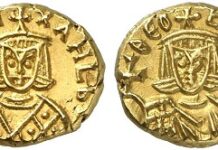Medieval Sicily Part 2: The Arabs
Since ancient times, Sicily has been a cultural melting pot, a junction of Africa and Europe, of West and East. In the 9th century, Arabs conquered the wealthy island.
The People of Zurich and their Money 14: Rich and Poor
Our series takes you along for the ride as we explore the Zurich of times past. This episode is about the different worlds in the year 1887. An American journalist first visited Aussersihl, a suburb of Zurich, and afterwards a businessman in his villa.
Human faces, part 28: Fight for Sicily
Why was the human head the motif on coins for centuries, no, for millennia? And why did that change in the last 200 years? Find out why the Houses of Anjou and Aragón fought for Sicily and how Ferdinand of Aragón cleverly used coins for propagandistic purposes in this episode.
A Coined History of the Islamic World
On 24 and 25 November, 2014, Numismatica Genevensis conducted an auction at Geneva. What made this auction catalog special: large parts of Islamic history can be reconstructed by a look at the coins offered there.
The Thirty Years’ War – Part 12 (1632)
Religion was of secondary importance in the Thirty Years’ War. It was all about power and money. Ursula Kampmann brings that era alive. Two men are fighting at the beginning of this episode: Wallenstein and Gustavus Adolphus. By the end of this episode, the Swedish king will be dead.
Human faces, part 41: Augsburg and the Thirty Years’ War
Being a Free Imperial City proved fatal for Augsburg during the Thirty Years’ War. This episode discusses the disastrous effects of the war on the city’s economic situation.
Expeditions into the realm of numismatics Part 2: Hercules in the backyard and a Paduan Hercules medal
In our series “Expeditions into the realm of numismatics”, we are taking you along on an expedition to the treasures of the Basel Coin Cabinet. In the second part, the mystery of a Hercules medal with a particularly high relief often attributed to the Paduan medallist Giovanni da Calvino will be solved.
Medieval Sicily Part 5: The Normans and the pope
As the strongest power in Lower Italy the Normans turned the scale in the conflicts between the pope, the antipope and the orthodox patriarch. Robert Guiscard skillfully used that to his advantage.
The People of Zurich and their Money 15: Migros causes revolution in food retail sector
Our series takes you along for the ride as we explore the Zurich of times past. In this episode you will listen to a Migros seller and a modern housewife talking back in 1925.
The Thirty Years’ War – Part 1
Both religion and power were the focal points of the Thirty Years’ War that shook the whole of Europe during the 17th century. Ursula Kampmann brings that era alive. Today you will learn about what this war was rooted in.












